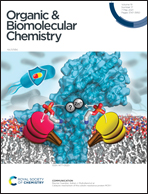Unexpected formal [4 + 2]-cycloaddition of chalcone imines and homophthalic anhydrides: preparation of dihydropyridin-2(1H)-ones†
Abstract
A series of medicinally important dihydropyridin-2(1H)-ones have been prepared via a novel [4 + 2]-formal cycloaddition reaction of chalcone imines and homophthalic anhydrides, which is a rare example of lactam construction from an imine acting as a four-atom building block. In contrast to previous studies on the reactivity of homophthalic anhydrides towards similar substrates, N-tosyl chalcone imines, we found the possibility of switching chemoselectivity by changing substituents at the nitrogen atom, which leads to the formation of heterocycles instead of the expected carbocycles. This reaction is very similar in appearance to the classic 1,2-addition of cyclic anhydrides to imines, often referred to as the Castagnoli–Cushman reaction, but differs in mechanistic details (representing a 1,4-reaction of imine). The developed atom-economical, stereoselective and catalyst- and chromatography-free protocol provided facile access to 28 structurally diverse heterocyclic products (in up to 88% yield) including synthetically challenging annelated tricyclic and previously unreported pentaaryl-substituted dihydropyridin-2(1H)-ones.
![Graphical abstract: Unexpected formal [4 + 2]-cycloaddition of chalcone imines and homophthalic anhydrides: preparation of dihydropyridin-2(1H)-ones](/en/Image/Get?imageInfo.ImageType=GA&imageInfo.ImageIdentifier.ManuscriptID=D1OB00534K&imageInfo.ImageIdentifier.Year=2021)
- This article is part of the themed collection: Synthetic methodology in OBC


 Please wait while we load your content...
Please wait while we load your content...